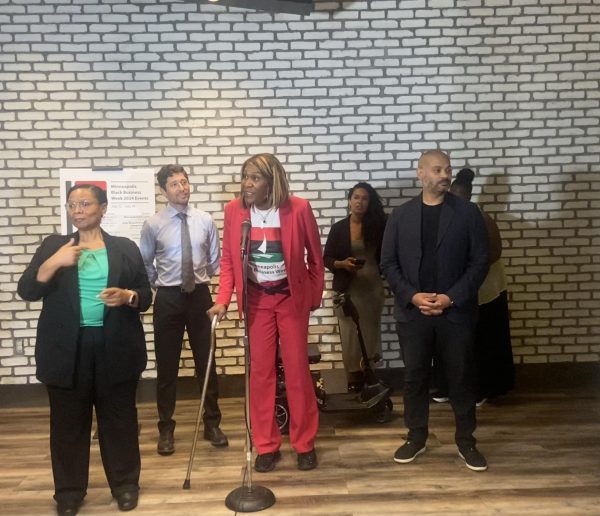‘It always feels like you need to prove yourself’: UMN contingent faculty speak out
Some contingent faculty said they have experienced issues including low pay, lack of promotional opportunities and job instability.
Image by David Stager
Lecturer Courtney Gildersleeve poses for a portrait outside of Nicholson Hall on Monday, Feb. 7.
When Courtney Gildersleeve left Vermont to attend graduate school at the University of Minnesota in 2007, she wanted to become a professor and inspire students.
Gildersleeve said in an interview with the Minnesota Daily that at the time, she thought she was making a practical financial investment that would pay off once she became a tenure-track professor. That did not become a reality.
“I was under the impression that once I did my Ph.D. work and finished my degree, that would be a path to becoming a professor,” said Gildersleeve, a cultural studies and comparative literature lecturer at the University. “I thought it would be a good financial investment to go to grad school, and it ended up putting me in a bad position in terms of debt.”
Gildersleeve now teaches one to two courses each semester based on her knowledge from academic and industry experience. Along with other contingent instructors, lecturers and adjunct faculty are often hired on a semester or yearly basis and paid less than their tenured faculty counterparts.
Lecturers and teaching specialists are required to hold the “degree expected of faculty in the department or substantial professional recognition in the field,” according to the University Policy Library. The same qualifications are also normally required for adjunct faculty. However, these instructors often have less job security and receive less monetary benefits, Gildersleeve said.
Gildersleeve said her experience is not unique. Other instructors in these contingent or adjunct positions highlighted the low salary, lack of job security and few promotional opportunities as some of the biggest issues in their career. These instructors, some who were not willing to be identified by the Daily due to job security concerns, said they hope to make the general public more aware of these issues.
According to these instructors, the COVID-19 pandemic made issues more visible.
For example, some academic departments experienced a tenured faculty shortage during the pandemic. This decrease was largely due to the University’s early retirement incentive and hiring freeze introduced in 2020 to generate savings during the pandemic, said Sauman Chu, College of Design (CDES) associate dean for academic programs and faculty affairs.
From 2019 to 2021, faculty in the College of Science and Engineering (CSE) decreased by 13 members while student enrollment increased by nearly 100 students, according to data from the University. Faculty employment decreased nearly 18% in the College of Design (CDES), losing 17 faculty.
The college needed adjunct and contingent instructors to continue teaching all of the necessary classes while working with a cut budget and retiring faculty during the pandemic, Chu said.
The history behind contingent instructors
“P&A [instructors] were conceived of as temporary instructors,” said Ascan Koerner, College of Liberal Arts (CLA) associate dean for undergraduate studies.
Contingent instructors are also referred to as academic professional and administrative (P&A) instructors.
Decades ago, universities expected tenured faculty would teach all courses at public universities, Koerner said. However, there were not enough funds to hire only tenure-track faculty positions.
While these positions started as a temporary need, contingent instructors started regularly teaching certain courses, like language learning courses, Koerner said.
“The reality is that there are many more people that are temporary,” Koerner said.
Wages
Gildersleeve said she earns about $700 every two weeks to teach one class, about as much money as she said she made teaching as a graduate student.
“It doesn’t feel like my degree is actually worth something in that sense,” Gildersleeve said.
Similar to Gildersleeve, some instructors said they grappled with low pay levels and looked for additional sources of income. All unnamed instructors have been given pseudonyms to avoid confusion.
Another lecturer, Emma*, who chose not to be identified because of concerns over long-term employment at the University, said she is teaching three classes this semester and will earn approximately $19,500 before taxes for the semester. The current cost of living in Hennepin County for a single adult with no children is about $35,000 per year.
“So people find themselves in situations where they might accept two classes at the U, they might pick up another class at a second university,” Emma said. “I’ve had years where I’ve taught seven classes at three universities … that’s a crushing amount of work.”
Most contingent instructors are primarily hired for teaching while faculty are expected to teach and complete research and service obligations, Koerner said.
“Since the tenure-stream faculty have both the research and the teaching and the service obligations, they’re relatively more expensive for the college than P&A,” Koerner said.
Opportunities for promotions and benefits
Lecturers and other academic professionals are not eligible for benefits unless they work full-time. According to Koerner, full-time for lecturers means teaching at least three classes per semester.
There are also limited promotional opportunities for contingent faculty, some instructors said. They said there can be limited tenure-track positions available at universities, which can lead instructors to accept contingent roles.
“There is nowhere for me to go to climb up, to have a more stable position, to earn more money,” Emma said.
Another contingent instructor, John*, who asked to remain anonymous because of job security concerns, has been a lecturer at the University for 20 years. The only promotional opportunity he had was his promotion to senior lecturer. This came with a small salary increase, but his income remains “very modest,” he said in an email to the Minnesota Daily.
“So even after 20 years as a lecturer, I’m still making what an entry-level high school teacher would make in the Twin Cities,” John said.
Positions are not guaranteed
Contingent instructors are hired on renewable contracts, meaning there is no “presumption of renewal,” Koerner said.
“You’re not firing a person,” Koerner said. “You just don’t give them another contract for the next year, so from a legal perspective, no explanation is needed.”
Koerner said the individual CLA departments largely make hiring and rehiring decisions, and hiring contingent faculty is dictated by how many courses a department offers each year that require contingent instructors. Since departments make these decisions, who makes hiring selections can vary.
“In many departments, it’s probably the chair who’s making those decisions, but then in some other departments, that might be an undergraduate curriculum committee … it varies,” Koerner said.
Departments can also make rehiring decisions based on criteria such as student feedback, like student rating of teacher surveys and peer reviews. There is no college-level process or requirement that every instructor is peer-reviewed, or any requirement to provide an explanation for not rehiring an instructor.
“When any successful instructor can still be fired at any time, it contributes to an environment of precarity and instability that all lecturers feel, including myself,” John said.
Emma said it can be unclear what courses, or even whether she will be teaching a course at the University at all, until a couple of weeks prior to the start of the semester. Their contracts also stipulate that their positions are not guaranteed.
“If [the classes] don’t fill, I will not be paid even though I may have turned down other work in order to accept this position,” Emma said. “We are asked to commit our time and our efforts ahead of the semester with very little protection after having dedicated our time.”
Personal impacts of these positions
Gildersleeve said a contingent position can be difficult to handle emotionally and sometimes feels demoralizing, especially because she has to reapply every year for her job.
“It always feels like you need to prove yourself,” Gildersleeve said.
These instructors said similar feelings can arise when the University announces large amounts of money will fund building renovations, contracts for sports coaches and for individuals in upper administration, like President Joan Gabel.
“It feels like there’s always enough money for major athletic programs … and it seems like there’s always money for new buildings or more administrative pay for top administrators,” Gildersleeve said. “It doesn’t always feel like teaching is valued in the way that it should be.”
Gildersleeve also said a student submitted her name for a teaching award, but she was not eligible for the award due to her status as a lecturer, rather than a full-time professor.
“Things like that are kind of painful,” Gildersleeve said.
Gildersleeve and other instructors said they worry about the effect this could have on students and their education.
It is difficult to maintain an ongoing professional relationship with students when an instructor does not know what course they will teach in the future, or if they will even be teaching, Gildersleeve said.
“The U can feel like a huge, anonymous place. Having instructors that they can get to know, trust, build a relationship with, and if they choose, to take another class with over the course of their college careers really helps their educational experience,” John said.
He said students benefit when instructors are able to put all of their energy into teaching instead of worrying about their employment for the next semester and applying to other jobs as “safeguards.”
“Teachers’ working conditions are students’ learning conditions,” John said.
Instilling change
Some instructors said they do not think many faculty and students are aware of these issues.
In May 2021, a College of Liberal Arts Academic Professionals and Administrators Professionalization Committee submitted a recommendations report to CLA Dean John Coleman for review. The report contained numerous recommendations to improve instructors’ employment conditions, including providing equitable representation in department governance, adding a promotion system and recognizing teaching excellence.
“My understanding is that most [issues in the report] have already been discussed during fall semester,” said Spanish lecturer Sara Mack in an email to the Minnesota Daily. “Given we’re operating in a pandemic, I am grateful these conversations are already happening.”
Koerner said CLA administration is working on updates to respond to the report.
“In CLA, we are aware of the real issue with how P&A are treated … and we are working on addressing these issues,” Koerner said.
The Office of Undergraduate Education is planning to implement a formal orientation for newly hired contingent instructors, and CLA is considering ways to provide more long-term contracts, Koerner said.
The college can give instructors three-year contracts but has not in the past because there was no formal way to predict class demand further than one year into the future. The college is now working on a process to predict demand, Koerner said.
“In many areas that employ P&A instructors, we know that there’s going to be demand for more than one year. We just never got around to formalize it,” Koerner said. “But we realized we needed to find a solution for that, so we’re working on that.”
Staying with the University
Despite the challenges, many instructors said they continue to work at the University because they love teaching.
“I’m totally dedicated to my field and I’m totally dedicated to the students I serve,” Emma said. “I love this work. I know I’m good at it, and I want to do it. I’d like to do it on terms that show a much stronger commitment to undergraduate education by the University.”
While Gildersleeve said there are many things she likes about the job and it “is something I’ve trained a long time for,” she has contemplated quitting numerous times for many reasons, including the working conditions.
“If there were a more fixed position that was focused primarily on teaching,” Gildersleeve said. “And the teaching dimension was seen and valued as a legitimate kind of scholarly endeavor, I might feel differently.”
*The names of Emma and John have been changed as they wish to remain anonymous due to concerns about job security at the University.
Correction: A previous version misstated how many courses Courtney Gildersleeve teaches per year. Gildersleeve teaches one to two classes per semester. A previous version of the photo caption misstated Courtney Gildersleeve’s position. Gildersleeve is a lecturer at the University.













